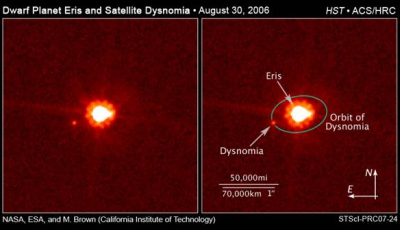18 June 2007

NASA's Hubble Space Telescope (HST) joined forces with the 10-m telescopes of W.M. Keck Observatory to yield a precise estimate of the mass of Eris, the largest dwarf planet. Eris (approximately 2,400 km across) is slightly larger in diameter than Pluto, the second largest dwarf planet. Now Eris is known to be 27% more massive than Pluto.
In 2005, a team of astronomers discovered Dysnomia, the only known moon of Eris. A series of images taken with HST and the Keck telescopes monitored the orbital motion of Dysnomia, allowing the computation of the mass of Eris to be computed.
Dr. Mike Brown (Caltech) and colleagues report in a recent issue of Science Magazine that Dysnomia orbits Eris every 16 days in a nearly circular orbit. These results support the postulate that Dysnomia originated in a massive collision between Eris and another Kuiper Belt Object (KBO), not a captured moon. The orbit of a gravitationally captured moon tends to be elliptical in shape.
Earth's Moon and the moons of Pluto are also believed to have been formed from the debris that resulted in violent impact processes.
Brown calculated a mean density of Eris of 2.3 g/cm3, which is similar to that of Pluto, and Neptune's largest moon, Triton (2,700 km across). This density indicates that these objects are not entirely icy in composition, but contain a significant amount of rocks.
Eris is the most distant known large object in the Solar System. Its maximum distance from the Sun (aphelion distance) is approximately 14.6 billion km, or over twice the average distance of Pluto from the Sun. In its vast orbit, Eris orbits the Sun every 560 years.
Since the announcement of the discovery of Eris in July 2005, Pluto has been suffering mishap. In April 2006, astronomers demonstrated that Eris is slightly larger than Pluto, then the ninth planet from the Sun, according to HST's data. In August 2006, the International Astronomical Union (IAU) set a new definition of the term planet, stripping Pluto of its planetary status, and demoting it to the newly adopted class of dwarf planets.
In early January 2007, dialect word "plutoed", which means fired, demoted or devalued, was chosen as Word of the Year of 2006.
Further Reading
Hubble Finds 'Tenth Planet' is Slightly Larger than Pluto
http://hubblesite.org/newscenter/archive/releases/2006/16/
Discovery of a Planetary-sized Object in the Scattered Kuiper Belt
http://hubblesite.org/pubinfo/pdf/2006/16/pdf.pdf
Aymen Mohamed Ibrahem
Senior Astronomy Specialist